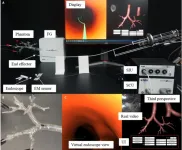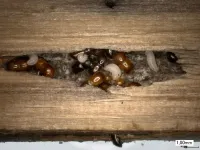(Press-News.org) Cancers are notoriously known for their high mortality rate and increasing incidence worldwide. Among them, lung cancer is arguably one of the most devastating ones. According to the World Cancer Research Fund International, lung cancer was the second most common cancer around the world in 2020, with more than 2.2 million new cases and 1.8 million deaths.
However, lung cancer, like other cancers, is easier to treat if caught earlier. “The reported 1-year survival rate for stage V is just 15% to 19% compared with 81% to 85% for stage I, which means that the early differentiation of benign and malignant pulmonary nodules, can effectively reduce mortality.” Said Xingguang Duan, a scientist from the School of Medical Technology, Beijing Institute of Technology.
Duan and his colleagues believe the early diagnosis of lung cancer is essential for timely treatment and better prognoses. To this end, they devised a novel robotic bronchoscope system that can non-intrusively access the area of interest within the lung for minimally invasive pulmonary lesions sampling, the gold standard of lung cancer diagnoses. This research was published on Mar. 15 in the journal Cyborg and Bionic Systems.
“Imagine inserting a long thin line into your mouth, through your airway to cut a little part of the lesion of interest within your lung. After that, this thin line brings the cut sample back for further examination to determine whether it’s benign or malignant.” Said study authors, “This is what the bronchoscope system was designed for. Our end effector is just like a thin line. To do so, this line must first be thin enough to cross the trachea and bronchus.”
“Moreover, it must be able to bend, rotate and translate to flexibly navigate the complex airway network.” explained Changsheng Li, the corresponding author of this research, from School of Mechatronical Engineering, Beijing Institute of Technology.
“Another problem is that you can’t see the end effector of this line through the patient’s chest. However, to accurately approach the lesion of interest, the position and pose of the end effector must be determined in real-time.” said study authors. They addressed this problem by developing a navigation system, which attaches an endoscope and two electromagnetic sensors to the end effector, which enables online positioning for navigation and provides visual information for doctors to diagnose and sample.
The navigation system also reconstructs a three-dimensional virtual model based on computed tomography for robotic path planning, provided with the choice of the target area. Combining the flexible end effector and the navigation system, the robotic bronchoscope system can automatically reach the target lesion and provide intraoperative visual guidance for biopsy sampling.
They verified the feasibility of this robotic bronchoscope system via an ex vivo navigation-assisted intervention experiment. “During the experiment, the position displayed by the third perspective of the virtual endoscope is consistent with the position of the end effector’s tip relative to the airway phantom from visual observation. The virtual endoscope view also matches with the real video acquired by the endoscope module as expected,” said Li.
“Although the system has achieved promising bronchoscopy performance, as a medical device, there are still some issues that limit the clinical application and promotion,” explained study authors, “First of all, the more convenient maneuver is required for surgeons to readily learn and use; Second, high-resolution endoscopic view is required; Finally, the calibration between virtual and actual environments is still time-consuming and unfriendly to the novice.”
In the future, they will focus on minimizing the diameter of the end effector and adopting replaceable modules for diverse surgical requirements, exploring joint control to allow the robot a more flexible movement in the airway, and adopting computer vision algorithms to realize automatic and intelligent calibration.
The authors of the paper include Xingguang Duan, Dongsheng Xie, Runtian Zhang, Xiaotian Li, Jiali Sun, Chao Qian, Xinya Song, and Changsheng Li.
The research is funded by Beijing Municipal Natural Science Foundation–Haidian Primitive Innovation Joint Fund Project, National Natural Science Foundation of China, and National Natural Science Foundation of China–Shenzhen Robotics Research Center Project.
The paper, “A Novel Robotic Bronchoscope System for Navigation and Biopsy of Pulmonary Lesions,” was published in the journal Cyborg and Bionic Systems at DOI: https://doi.org/10.34133/cbsystems.0013
Reference
Authors: Xingguang Duan1,2, Dongsheng Xie1, Runtian Zhang2, Xiaotian Li2, Jiali Sun2, Chao Qian2, Xinya Song1, and Changsheng Li2
Title of original paper: A Novel Robotic Bronchoscope System for Navigation and Biopsy of Pulmonary Lesions
Journal: Cyborg and Bionic Systems
DOI: 10.34133/cbsystems.0013
END
A novel robotic bronchoscope system for navigation and biopsy of pulmonary lesions
2023-04-14
ELSE PRESS RELEASES FROM THIS DATE:
Black cancer patients 71% more likely to experience heart damage following chemotherapy treatment
2023-04-14
Chemotherapy is associated with an increased risk of treatment-related heart damage, including heart failure and cerebrovascular disease, for many patients. But a new meta-analysis, presented at the American College of Cardiology’s Advancing the Cardiovascular Care of the Oncology Patient 2023 conference, finds that Black patients or patients of African ancestry have 71% higher odds of cardiotoxicity following cancer treatment compared to White patients.
Cardiotoxicity is any heart damage stemming from cancer treatment or drugs, including ...
Optica Publishing Group announces launch of Optica Quantum
2023-04-14
WASHINGTON—On World Quantum Day, Optica Publishing Group announced it will begin publishing a new journal in September 2023 dedicated to highly selective results in quantum information science and technology (QIST). The new journal, Optica Quantum, joins the Society’s portfolio of the most-cited journals in optics and photonics and will provide the community with articles of the same exceptional standards for quality, novelty, and significance as its parent journal, Optica.
The concept of quantum light serves as a foundation for many quantum technologies and ongoing ...
Farmer’ beetle finds suitable host trees by tracing scent of its fungus crop
2023-04-14
The alnus ambrosia beetle Xylosandrus germanus, also known as the black stem borer, was accidentally introduced by humans from its native east Asia to North America and Europe around the beginning of the 20th century. X. germanus is a so-called ambrosia beetle, which means that it farms its own food: a specialized fungal symbiont which it ‘sows’ and tends inside the galleries that it digs inside wood. It is a destructive invasive pest, known to attack more than 200 species from 51 families of broadleaf and conifer trees. While it prefers to colonize dead ...
Treasure hunt in hot springs?
2023-04-14
The demand for precious metals and rare earths is expected to continue increasing in the future. Due to limited production areas, recycling from precision equipment and recovering from seawater and hot spring water are needed to ensure a stable supply.
A research group led by Professor Masayuki Azuma and Associate Professor Yoshihiro Ojima of the Osaka Metropolitan University Graduate School of Engineering has successfully developed an adsorbent material that can selectively recover rare earth elements (REEs) using environmentally friendly and inexpensive baker’s yeast and trimetaphosphate, which is used as a food additive.
The research group conducted experiments using ...
Why did the mpox (monkeypox) epidemic wane? Belgian researchers propose theory
2023-04-14
**Note: the release below is from the European Congress of Clinical Microbiology & Infectious Diseases (ECCMID 2023, Copenhagen, 15-18 April). Please credit the conference if you use this story**
Did the recent mpox (formerly known as monkeypox) outbreak end because of “network immunity”? That’s the theory being put forward by Belgian researchers at this year’s European Congress of Clinical Microbiology & Infectious Diseases (ECCMID) in Copenhagen, Denmark (15-18 April).
2022 saw a global outbreak of mpox, a viral ...
The Lancet Public Health: Hearing aids may protect against a higher risk of dementia associated with hearing loss, study suggests
2023-04-14
Peer-reviewed / Observational study / People
The Lancet Public Health: Hearing aids may protect against a higher risk of dementia associated with hearing loss, study suggests
Study of 437,704 people suggests those experiencing hearing loss and not using hearing aids may have a higher risk of dementia than people without hearing loss. Those using hearing aids did not appear to be at an increased risk of dementia.
After adjusting for other factors, study analysis suggests a 1.7% risk of dementia in people with hearing loss who are not using hearing aids, compared to 1.2% among those without hearing loss ...
One of first studies to assess new bivalent Covid-19 booster vaccine shows it is highly effective in reducing deaths and hospitalizations
2023-04-14
*Note: this is a joint press release from the European Congress of Clinical Microbiology & Infectious Diseases (ECCMID) and The Lancet Infectious Diseases. Please credit both the congress and the journal in your stories*
Since September, 2022, bivalent mRNA vaccines – which contain elements from both the original wild type COVID strain and an updated component from the omicron strain – have replaced older style monovalent boosters in the USA, Israel, and other countries. These vaccines were designed to help improve vaccine-induced immunity against the omicron variant and subsequent subvariants.
A new study published in The Lancet Infectious Diseases and ...
A $1 million boost to UT’s venture culture
2023-04-14
Adding fuel to The University of Texas at Austin’s startup engine, alumnus William “Billy” Freed, BBA ’81, and his family have given $1 million to the Herb Kelleher Entrepreneurship Center in the McCombs School of Business.
The gift establishes the Freed Family Entrepreneurship Excellence Fund and endows the Freed Family Pitch Competition, previously called DisrupTexas. Freed’s wife Cheryl, BA ’82, JD ’84; sons Tyler, BS ’17, and Russell, BBA ’21; and daughter-in-law Leslie Lugrin Freed, BS ’17, ...
Data can now be processed at the speed of light!
2023-04-14
How can Marvel movie character Ant-Man produce such strong energy out of his small body? The secret lies in the “transistors” on his suit that amplify weak signals for processing. Transistors that amplify electrical signals in the conventional way lose heat energy and limit the speed of signal transfer, which degrades performance. What if it were possible to overcome such limitation and make a high-performance suit that is light and small but without loss of heat energy?
A POSTECH team of Professor Kyoung-Duck Park and Yeonjeong Koo from the Department of Physics and a team from ...
Disrupted rhythms of rest and wakefulness contribute to worse symptoms in schizophrenia patients
2023-04-14
PITTSBURGH, April 13, 2023 – In a paper published today in Molecular Psychiatry, a team of scientists from the University of Pittsburgh in collaboration with researchers in Italy described shared patterns of sleep disturbances and irregularities in daily rhythms of rest and activity across patients with schizophrenia spectrum disorder, or SSD.
By using wrist monitors that measured activity and rest as proxies of wakefulness and sleep, researchers found that individuals with SSD who resided in psychiatric hospitals and those who manage their condition in outpatient settings had erratic sleep patterns, dysregulated transitions between sleep ...






